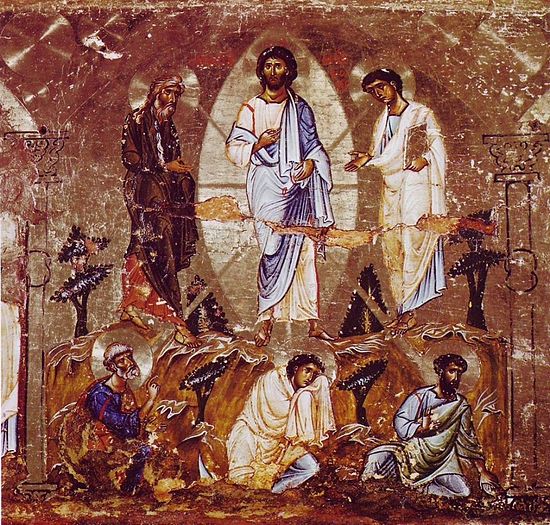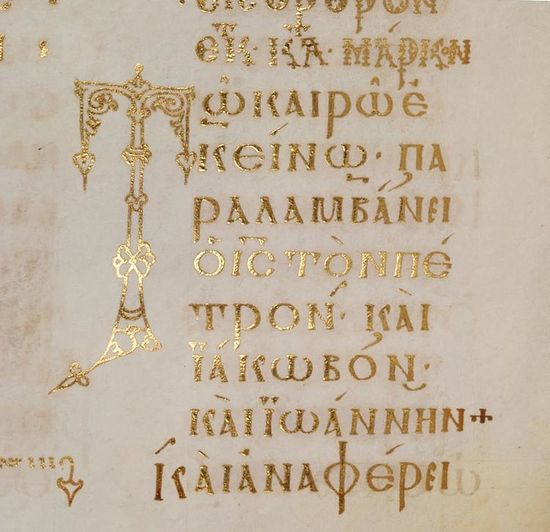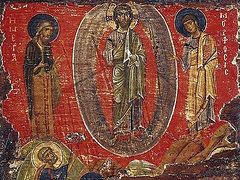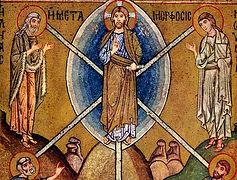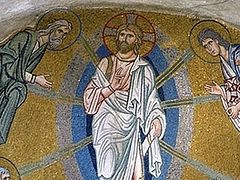“Jesus goes before us to show us the way, both up the mountain and into heaven.”
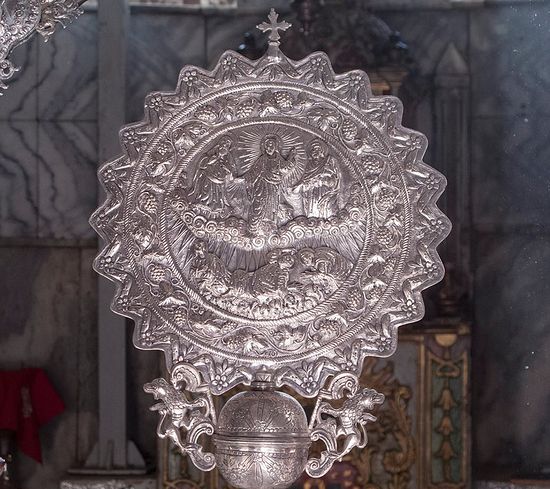 "And, behold, there talked with him two men, which were Moses and Elias: who appeared in glory, and spake of his decease which he should accomplish at Jerusalem." A ripidion from the altar depicts the Holy Transfiguration to which the Sinai church was dedicated.
"And, behold, there talked with him two men, which were Moses and Elias: who appeared in glory, and spake of his decease which he should accomplish at Jerusalem." A ripidion from the altar depicts the Holy Transfiguration to which the Sinai church was dedicated. At the foot of the God-trodden Mountain of Sinai, Emperor Justinian built the great basilica of St. Catherine's Monastery to the Transfiguration of Christ—the “Feast of monastic feasts.”
“Let us be transfigured by that glorious transfiguration,” exhorted St. Anastasios of Sinai in his sermon on the Feast, for “Jesus goes before us to show us the way, both up the mountain and into heaven … making us sharers in His divinity and raising us to heights as yet undreamed of.”
Archbishop Damianos of Sinai has pointed out that the manifestation of the Holy Trinity at the Transfiguration was foreshadowed by the earlier theophany on Mount Sinai, where the voice of God, the light of the Sun of Righteousness, and the cloud of the Holy Spirit were all similarly present.
There is a difference though: While the eyes of the apostles were enabled to see “a dim ray” of the divine radiance of Christ at His Transfiguration, the Uncreated Light appears to Moses on Sinai as “luminous darkness.” It is invisible—except to eyes that have been transformed by the Holy Spirit.
As His Eminence also noted, the full revelation of the Trinity is reserved for the New Testament. Thus the wishes of both Moses and Elias to see God clearly on Sinai are fulfilled at the Transfiguration of Christ.
As the iconic figures of the Law and Prophets, Moses and Elias are called there to bear the witness of the Old Testament upon the fulfillment of its entire revelation in Christ, “the beginning and end of every prophetic utterance and law,” wrote St. Gregory of Sinai in his Discourse on the Transfiguration.
More so than the icons of his own era, Gregory’s theological reflections recall Sinai’s famed mosaic Transfiguration, which struck Princeton’s Kurt Weitzmann as “a vision of heaven in the wilderness of Moses.”
Similarly to the unusual Sinai icon below with its polished gold rays of light extending from the mandorla of Christ, the very early Transfiguration mosaic is formed on the proportions of the Greek cross. All figures remain equidistant from Christ, without the vertical elongation of the hierarchical plan that later came to distance the Lord and His prophets from the apostles.
Gregory would have had ample opportunity during the lengthy monastic services to study the mosaic, for his 13th century tenure on Sinai predated the massive Cretan iconostasis which has prevented view of the mosaic from the nave since the 16th century.
While his ascetic cell was high on the Mountain, according to monastic custom, Gregory would have descended to the Monastery for the church services on the great Feasts. In fact, his commentary on Moses and Elias focuses on the same nuanced points brought out in the hymns and readings from the Vespers of the Transfiguration, especially regarding the significance of the Old Testament prophets' presence at the Transfiguration, many centuries after their earthly lives.
While Moses appeared “from out the grave,” Gregory emphasized, Elias had never died. Their presence at the Transfiguration thus proves Christ to be God of both the living and the dead, “the Word which existed before all ages, flashing forth as lightning and resplendent beyond the sun as God, before whom the powers from above shuddered, and the earth from below trembled with joy.”
Christ Himself thus answers the question He had posed to His apostles, noted the mystic Gregory, just a few days before his Transfiguration:
Who do you say I am?
The most crucial question, it has been noted, that every human being will ever answer for himself.
* * *
A significant characteristic of Orthodox Christianity is its understanding of the distinction between the essence of God and His uncreated energies; Orthodox saints understand creation as the voluntary will of the divine energies, an outpouring of love—reflected in the words of the Holy Trinity, Let us make man.
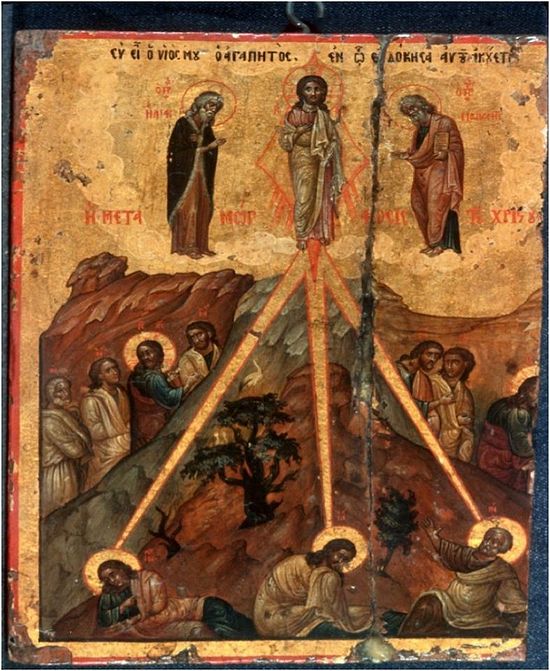
What does this mean? That man is destined not for contemplation of God, but for union with Him. Receiving the divine energies within himself, he is created “to become by grace what God is by nature.”
It also means that salvation is not reserved for a chosen few, but the free gift of grace offered to all. One need only reach out to take the gift, striving to follow Christ through the mysteries of the historic Orthodox Church founded by Christ through His apostles.
Thus, St. Gregory of Sinai says that Peter, James, and John were not randomly selected to participate in the Transfiguration, for each was distinguished by some individual combination of “faith, effort, and love for—even though the same grace of the Spirit had been given to all.”
Enamored of the divine radiance, Peter exclaims, Lord, it is good for us to be here! His next thought is to remain in the divine glory.
At this point—validating the faith of Peter who had replied You are the Christ, the Son of the living God to Jesus' question six days earlier, Who do you say I am?—the voice of the Father comes from the cloud: 'This is my beloved —listen to him.'
This is the exact moment portrayed in the icon of the Transfiguration—as illustrated in the Sinai icon above with the words of the Father inscribed across the top—portraying not just the divine energies of God's unapproachable glory—but how one may remain within it:
Geronta Pavlos of Sinai explains that the New Testament verb for “listen” implies “doing.” Those who seek union with God by fulfilling His commandments will be transfigured by the light of Christ into the abode of the Holy Spirit, and through them, all creation.
According to the patristic Saints of the Orthodox Church, this is the radiant message of the Feast of the Transfiguration of the Saviour, whose week-long celebration will draw to its close on August 13th, but which never dims in the hearts of the faithful.
I, light, have come into the world, said the Lord, that whoever believes in me not remain in darkness.
* * *
Sinai's Codex Theodosianus is one of the most splendid manuscripts to survive from Byzantine times. It is a copy of the Gospels, written in Constantinople in the tenth century. It was written in one of the imperial scriptoria, and every letter on every page is executed in gold leaf. The beautiful letters gleam and flash as they catch the light.
This image below shows the beginning of the Gospel passage for the Feast of the Transfiguration. One can see here the abbreviation for the Name “Jesus” formed by its first and last letters, with a decorative line above to indicate the contraction. Names such as “Jesus Christ” and ‘Lord” were always written as abbreviations, in that they are nomina sacra, “sacred names.”

